
The Star Tribune is the largest newspaper in Minnesota. It originated as the Minneapolis Tribune in 1867 and the competing Minneapolis Daily Star in 1920. During the 1930s and 1940s, Minneapolis's competing newspapers were consolidated, with the Tribune published in the morning and the Star in the evening. They merged in 1982, creating the Star and Tribune, and it was renamed to Star Tribune in 1987. After a tumultuous period in which the newspaper was sold and re-sold and filed for bankruptcy protection in 2009, it was purchased by local businessman Glen Taylor in 2014.
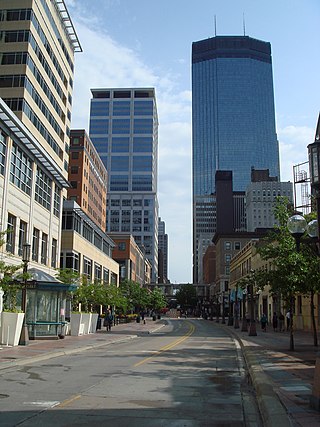
Nicollet Mall is a twelve-block portion of Nicollet Avenue running through downtown Minneapolis, Minnesota, United States. It is the shopping and dining district of the city, and also a pedestrian mall and transit mall. Along with Hennepin Avenue to the west, Nicollet Mall forms the cultural and commercial center of Minneapolis.

The McNamara Alumni Center at the University of Minnesota's Twin Cities campus in Minneapolis, Minnesota. Designed by Antoine Predock, it is one of the more architecturally striking buildings in the Twin Cities. The building, opened in 2000, contains two main components: University office space and 10 meeting rooms for University and public use. The University owns the land, but the University of Minnesota Gateway Corporation, consisting of the U of M Foundation and U of M Alumni Association, owns the structure.

Whittier is a neighborhood within the Powderhorn community in the U.S. city of Minneapolis, Minnesota, bounded by Franklin Avenue on the north, Interstate 35W on the east, Lake Street on the south, and Lyndale Avenue on the west. It is known for its many diverse restaurants, coffee shops and Asian markets, especially along Nicollet Avenue. The neighborhood is home to the Minneapolis Institute of Art, the Minneapolis College of Art and Design, and the Children's Theatre Company.
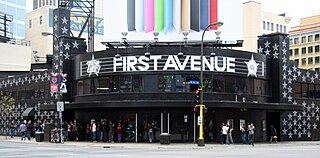
First Avenue & 7th St Entry are two historic music venues housed in the same landmark building in downtown Minneapolis, Minnesota. The nightclub sits on the corner of First Avenue North and 7th Street North, from which the venues get their names. The two are colloquially distinguished by locals as The Mainroom and The Entry.

Saint Anthony Main refers to an area of buildings with multiple owners located on Main Street across from Saint Anthony Falls in the Nicollet Island/East Bank, Minneapolis section of Southeast, Minneapolis in the U.S. state of Minnesota. Commonly the area is associated with Northeast, Minneapolis as it is actually northeast of downtown on the east side of the Mississippi River. It opened as a festival marketplace in the 1980s.
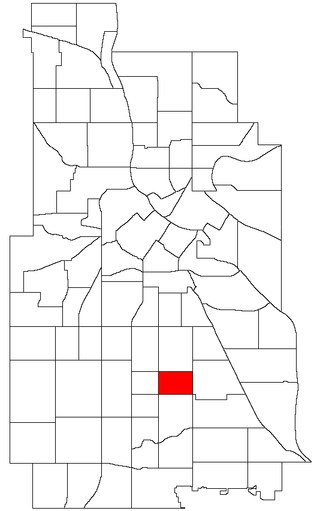
Bancroft is a neighborhood within the Powderhorn community in Minneapolis, Minnesota, United States. Its boundaries are East 38th Street to the north, Chicago Avenue to the west, East 42nd Street to the south and Cedar Avenue to the east.
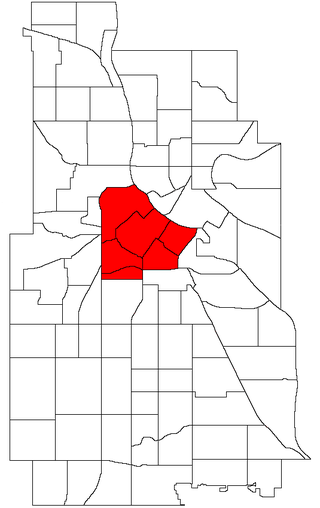
The Central Minneapolis community is located in the central part of the city, consisting of 6 smaller official neighborhoods, and includes Downtown Minneapolis and the central business district. It also includes the many old flour mills, the Mill District, and other historical and industrial areas of Downtown Minneapolis. It also includes some high-density residential areas surrounding it, excluding areas east of the Mississippi River. Businesses based in the Central area include the corporate headquarters of Target, US Bank, and the broadcast facilities of Minnesota CBS station WCCO-TV.

Downtown West is an official neighborhood in Minneapolis, part of the larger Central community. It is the heart of downtown Minneapolis, containing the bulk of high-rise office buildings in the city, and is what comes to mind when most Minneapolitans think of "downtown".

Como is a neighborhood within the University community of Minneapolis. It is sometimes referred to as Southeast Como, due to many of its streets ending in SE, and possibly to differentiate it from the Como neighborhood in neighboring Saint Paul. Its boundaries are East Hennepin Avenue to the north, 33rd Avenue Southeast to the east, the Southeast Industrial Area to the south, and Interstate 35W to the west.
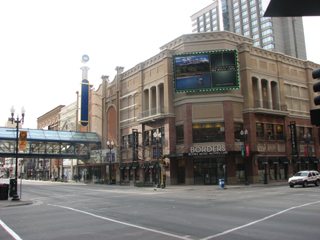
Mayo Clinic Square on Block E in downtown Minneapolis, is a building bounded by Hennepin Avenue, North 6th Street, North 7th Street, and 1st Avenue North. It is part of the Downtown West neighborhood in Minneapolis, historically known as the Warehouse District. It is one block south of the Warehouse District/Hennepin Avenue light rail station on the METRO Blue and Green lines. "Block E" is a City planning department designation of the block; other blocks have similar designations

The Mill District is a neighborhood within Minneapolis, Minnesota, United States, and a part of the larger Downtown East neighborhood. The neighborhood contains several former flour mills left over from the days when Minneapolis was the flour milling capital of the world. With almost none of the mills still active, a number of these have been converted into condominiums leading to a revitalization of the neighborhood.
Minnesota Center for Book Arts (MCBA) is the largest and most comprehensive independent nonprofit book arts center in the United States. Located in Minneapolis, Minnesota, MCBA is a nationally recognized leader in the celebration and preservation of traditional crafts, including hand papermaking, letterpress printing and hand bookbinding, as well as the use of these traditional techniques by contemporary artists in creating new artists' books and artwork.

Minneapolis Central Library, a library in downtown Minneapolis, Minnesota, United States, is the largest library of the Hennepin County Library public library system. It bills itself as having "the third largest per capita public library collection of any major city in America with a collection of more than 2.4 million items—including books, DVDs, music, government documents." The 353,000-square-foot (32,800 m2) building at 300 Nicollet Mall with two levels of underground parking was designed by César Pelli and opened on May 20, 2006. It has over 300 computers for use by the public, an 8,140-square-foot (756 m2) atrium, an 18,560-square-foot (1,724 m2) green roof planted with low-growing ground cover designed to "be sun- and drought-resistant", and a host of energy-efficiency measures.

The Minneapolis Forum Cafeteria was located at 36 South 7th Street originally constructed in 1914 as the Saxe Theater, later the Strand Theater. A 1930 reconstruction created a cafeteria with a stunning Art Deco interior of black onyx and pale green tiles, sconces, chandeliers, and mirrors with a Minnesota-themed motif: pine cones, waterfalls, and Viking ships.

Pizza Lucé is a pizzeria restaurant company in Minnesota with locations in the Minneapolis–Saint Paul area and Duluth. Pizza Lucé was founded in 1993.

Selby Avenue is a street in Saint Paul, Minnesota, United States, that runs east–west from Summit Avenue near downtown toward the Mississippi River. The street runs through the Summit-University and Union Park neighborhoods. The street, especially between Dale Street and Snelling Avenue, has been associated with Saint Paul's black community. The far eastern end of the street has historically been more densely developed and architecturally significant.

The New Riverside Cafe was a coffeehouse and vegetarian restaurant located near the University of Minnesota in the West-Bank neighborhood of Minneapolis, Minnesota, from 1970 to 1997. It became a center for political and social movements around revolutionary politics.

The Palace Theatre is a historic theater in Saint Paul, Minnesota. Dating from 1916, it was renovated in 2016 to become a live music venue.

Minneapolis City Center is a mixed-use shopping mall on Nicollet Mall in Minneapolis, Minnesota. It opened in 1983 and occupies the bottom three floors of the 33 South Sixth office building. Designed by Skidmore, Owings & Merrill, Minneapolis City Center contains 250,000 square feet (23,000 m2) of leasable retail space. The mall was built around the pre-existing Forum Cafeteria restaurant. The building is adjacent to the Marriott Hotel City Center and connected to the Gaviidae Common shopping mall.



















